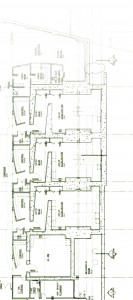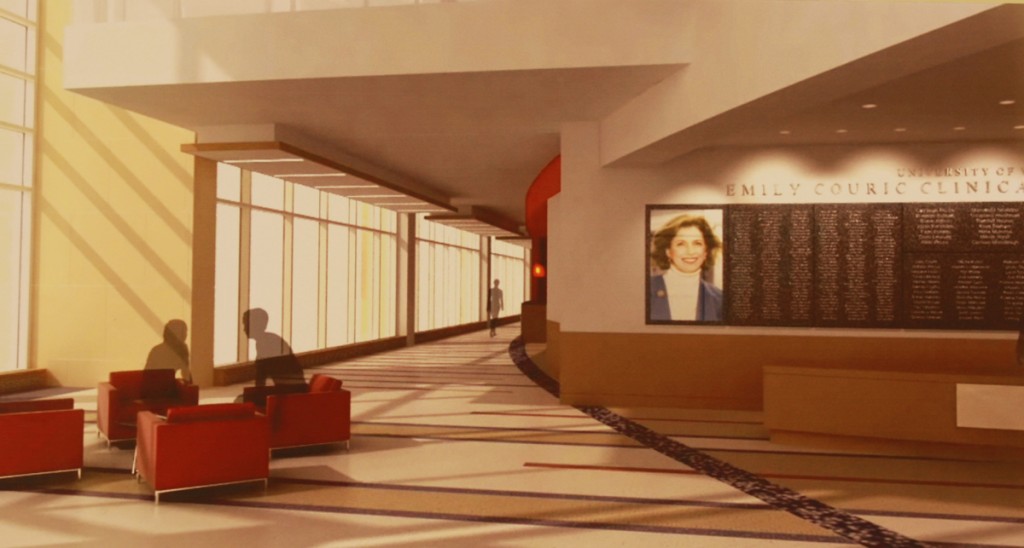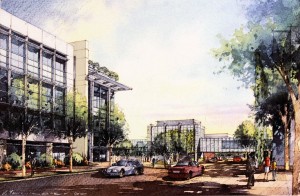Part II: Fruition
Fruition
by Peyton T. Taylor, Jr., M.S., M.D.
The Cancer Center at the University of Virginia in the last three decades has been in a constant state of transition, slowly working towards the long-held dream of an independent cancer center. As different physicians and health care workers have joined and left the effort, the very nature and focus of medical care has changed and the vision for the cancer center has shifted as well. We have made significant changes in the structure and focus of care provided to cancer patients at the University Hospital since the 1980s. Peter Quesenberry, M.C. Wilhelm, and I, under the direction of Robert Wagner, broke down the divisive administrative structure to provide a more collaborative and integrative base to clinical care of cancer at UVa. Collaboration and a more holistic approach to patient care were welcomed by patients and their families. The professional and support staff also embraced the new model of care enacted in earlier entities of the Cancer Center. These earlier experiences at the University Hospital undeniably formed the rationale for the development of a free-standing clinical care center, whose construction is currently nearing completion.

Blueprint of the ECCC (edited), from Zimmer Gunsul Frasca Architects LLP (ZGF), Seattle, Washington, US.
We began formal planning for a new, free-standing ambulatory facility in early 1999. As Medical Director, I spearheaded the first planning and design team along with Barry Anderson, who subsequently became the Cancer Center Administrator. In order to broaden the scope of our planning process we hired an architecture firm of national renown, SmithGroup. They choreographed a detailed self-study program involving more than 120 faculty physicians, nurses, and support staff in the pre-planning process. Participants were charged to help design a working environment which would best allow them to provide their patients with optimal care. In line with our greater collaborative and patient-focused treatment plan, we also began to coordinate focus groups with patients’ families and friends and community members. Attendees were asked what they would like to see in the new building in order to ensure that it would be more convenient, recognize patient concerns, and create a welcoming, warm, and supportive environment in which to receive care. We also involved members of the greater community, for example, the local and state law enforcement authorities, fire and emergency services, and federal regulatory agencies. We wanted to guarantee that our layout would help us meet their needs if we ever called upon them for security or emergency support and thus provide for the safety of both visitors and staff members.
The Health System Administration made the decision to locate the new building on the site of the first of two parking decks on Lee Street. The Center then would have a central location, directly across the street from the main hospital building. We wanted the facility to become an architectural focal point and to serve as the ‘gateway’ to the health care complex. Once this had been decided, we turned to the task of finding an architectural firm to draft our plans into an actual structural plan. Prominent architectural groups from across the United States and the United Kingdom submitted design proposals for the new Center. From this group, the University selected the experienced and creative firm of Zimmer Gunsul Frasca Architects (ZGF) to convert our concepts of care into a beautiful and highly functional building. ZGF continued to emphasize the collaborative nature of the design process and the multi-faceted needs of the center. They created a small design team internal to the medical center, consisting of doctors, nurses, technologists, administrators, and educators. The firm took this team on field trips to both coasts of the U.S. to visit the latest and most successful cancer centers in order to assess both the strong and weak points of existing centers from an architectural as well as practical, medical vantage point.
The design of the center was the fruition of not only all of this planning and attention, but also years of improving the care cancer patients receive at the University of Virginia. Upon arrival, patients will enter the Cancer Center through an inspirational atrium, filled with an abundance of natural light. Wood and stone create a warm and inviting feeling as patients and their families prepare for a difficult experience. In spite of the size of the building (154,000 square feet), the architects have managed to create a very ‘human scale’. The planning team desired to create an environment of support to care for individuals and families struggling with a transformative diagnosis, not just a place to treat patients with a disease.
Moreover, the design of the center reveals the center’s integrative, patient-centric approach to treatment. Patient support and education services are located in the center of the main floor to emphasize our commitment to holistic and supportive care—e.g., social work, counseling, spiritual support, image recovery boutique, refreshment nook, and a quiet contemplative space with a reflective garden for meditation. Each floor of the building also has a geographic theme to ensure that people from every corner of the commonwealth will find something of ‘home’ here. The decorative premise and color palates reflect the mountains, the Piedmont, the coastal plains, and the Great Valley of Virginia.

Artist Rendering of the ECCCC from Zimmer Gunsul Frasca Architects LLP (ZGF), Seattle, Washington, US.
The new center also integrates the latest technology in diagnostics and treatments. The main floor houses an impressive Diagnostic Imaging Clinic with PET, SPECT, CT, and combination imaging services. The ground floor is home to an impressive 28,000 square foot Department of Radiation Oncology. There are three of the latest linear accelerators, a brachytherapy suite, and a simulation suite. There is also an area for chemotherapy infusions for those receiving concurrent chemotherapy and radiation therapy, as well as exam and consultation rooms, and radiation support services.
The second floor is home to the Women’s Oncology Clinics (Breast and Gynecological Malignancies), the investigational pharmacy, and a remarkable and spacious infusion facility for the administration of commercial and investigational chemotherapy, immunotherapy, and gene therapy. Moreover, each of the eighteen private infusion rooms has a window to create a warmer, less institutional space for the patient. There are also communal rooms for those who wish to receive chemotherapy in a group setting and eight private day beds for those not feeling well or those on prolonged treatment programs, such as intraperitoneal therapy.
The third floor is the site of the majority of the multidisciplinary clinics, where teams of medical/surgical oncology physicians and nurses practice (e.g., Lung Cancer Team, GI Malignancies, Hepato-biliary Malignancies, Melanoma, Lymphoma/Leukemia Team, General Oncology). Each of the teams consists of a medical oncologist, surgical oncologist, radiation oncologist, pathologist, diagnostic radiologist, and support services. This floor also houses the Clinical Trial Support offices to facilitate participation of patients in trials and the staff’s ability to do research. A conference room with remote teleconferencing capability allows site-specific Tumor Boards to integrate care and staff to consult with distant physicians. At present, the fourth floor has only been shelled in to allow for future growth. Again, embodying our understanding of the experience of cancer for patients, their families, and the individuals who treat them, there will be a reflective terrace garden for patients and staff to seek solace.
This new building will provide the opportunity to bring together the majority of adult cancer care physicians, nurses, educators, and psychosocial support care providers under one roof, allowing patients to receive most of their ambulatory diagnostic and treatment at one site. This concentration of diagnostic, support and treatment services will be unparalleled in all but a very few places. The Emily Couric Clinical Cancer Center was named in honor of the late Virginia Senator, Emily Couric. She was a courageous individual and very public with her struggle with pancreatic cancer. Senator Couric was a champion and vocal advocate for the inspiration that the latest in cancer diagnosis and treatment should be available to citizens throughout the commonwealth. But beyond that, she emphasized that this elite care should be provided in an environment respectful and supportive of everything with which the patients struggle. Without her voice, and those of other patients like her and their family members, we would not be where we are today. The Emily Couric Clinical Cancer Center truly embodies the progress and hope of collaborative, patient-centered cancer care.
